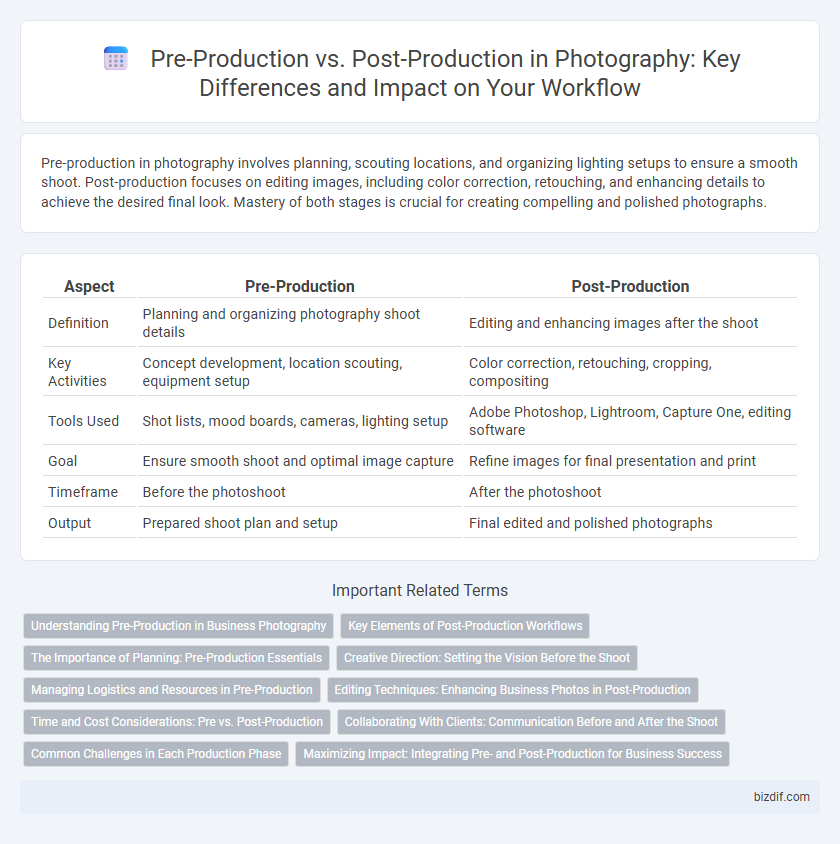Pre-production in photography involves planning, scouting locations, and organizing lighting setups to ensure a smooth shoot. Post-production focuses on editing images, including color correction, retouching, and enhancing details to achieve the desired final look. Mastery of both stages is crucial for creating compelling and polished photographs.
Table of Comparison
| Aspect | Pre-Production | Post-Production |
|---|---|---|
| Definition | Planning and organizing photography shoot details | Editing and enhancing images after the shoot |
| Key Activities | Concept development, location scouting, equipment setup | Color correction, retouching, cropping, compositing |
| Tools Used | Shot lists, mood boards, cameras, lighting setup | Adobe Photoshop, Lightroom, Capture One, editing software |
| Goal | Ensure smooth shoot and optimal image capture | Refine images for final presentation and print |
| Timeframe | Before the photoshoot | After the photoshoot |
| Output | Prepared shoot plan and setup | Final edited and polished photographs |
Understanding Pre-Production in Business Photography
Understanding pre-production in business photography is crucial for ensuring a smooth and efficient shoot. It involves detailed planning such as location scouting, coordinating with clients, selecting appropriate equipment, and defining stylistic goals to align with the brand's image. Effective pre-production minimizes costly delays and enhances the overall quality of the final images.
Key Elements of Post-Production Workflows
Post-production workflows in photography primarily involve color grading, retouching, and compositing to enhance image quality and visual storytelling. Key elements include precise adjustment of exposure and contrast, application of selective sharpening, and seamless integration of multiple image layers to achieve the desired aesthetic. Efficient use of software tools like Adobe Photoshop and Lightroom accelerates workflow while maintaining high-resolution output and consistent color profiles.
The Importance of Planning: Pre-Production Essentials
Pre-production in photography involves essential planning steps such as concept development, location scouting, and scheduling, which establish a clear vision and streamline the shoot. Proper pre-production minimizes unexpected challenges, ensuring efficient use of time and resources during the session. This foundational phase directly impacts the quality and coherence of the final images by providing a structured workflow before post-production enhancements.
Creative Direction: Setting the Vision Before the Shoot
Creative direction in pre-production establishes the visual style, mood, and narrative goals, ensuring alignment among photographers, models, and stylists. This phase involves detailed planning of composition, lighting, and location choices to create a cohesive vision before the shoot begins. Post-production focuses on refining images through color correction, retouching, and effects to enhance the initial creative intent set during pre-production.
Managing Logistics and Resources in Pre-Production
Managing logistics and resources in pre-production involves careful scheduling of photo shoots, securing locations, and coordinating with models, stylists, and crew to ensure smooth workflow. Budget allocation for equipment rentals, permits, and travel expenses is critical to prevent delays and overspending. Efficient resource management during pre-production sets the foundation for a successful photography project by minimizing risks and optimizing downtime.
Editing Techniques: Enhancing Business Photos in Post-Production
Editing techniques in post-production play a crucial role in enhancing business photos by adjusting exposure, color balance, and sharpness to create a polished and professional look. Retouching tools remove imperfections, while background modifications improve focus and brand consistency. These enhancements ensure images effectively communicate the intended message and appeal to the target audience.
Time and Cost Considerations: Pre vs. Post-Production
Pre-production in photography demands significant time investment for planning, location scouting, and equipment setup, often incurring upfront costs but preventing expensive reshoots. Post-production involves software-based editing that can be time-intensive, especially for complex retouching, with costs varying depending on software licenses and professional expertise needed. Efficient pre-production reduces overall project expenses by minimizing extensive post-production corrections, balancing the time and cost between both phases effectively.
Collaborating With Clients: Communication Before and After the Shoot
Effective collaboration with clients hinges on clear communication during both pre-production and post-production phases. Before the shoot, detailed discussions about vision, style, and expectations ensure alignment and minimize misunderstandings. After the shoot, sharing previews, gathering feedback, and making necessary edits foster client satisfaction and refine the final images.
Common Challenges in Each Production Phase
Pre-production challenges in photography often include limited budget allocation, inadequate planning, and difficulty in scouting ideal locations, which can compromise the shoot's overall quality and timelines. Post-production struggles frequently involve managing extensive image editing workloads, maintaining color accuracy, and ensuring consistency across a photo series, which require advanced software skills and time management. Both phases demand strong communication and organizational skills to align creative vision and technical execution effectively.
Maximizing Impact: Integrating Pre- and Post-Production for Business Success
Maximizing impact in photography requires seamless integration of pre-production and post-production phases to enhance overall project efficiency and quality. Strategic planning during pre-production, including scouting locations, deciding lighting, and storyboarding, sets a strong foundation that optimizes post-production workflows like editing, color grading, and retouching. Aligning these stages ensures cohesive storytelling and consistent branding, driving greater business success through compelling visual content.
Pre-Production vs Post-Production Infographic

 bizdif.com
bizdif.com